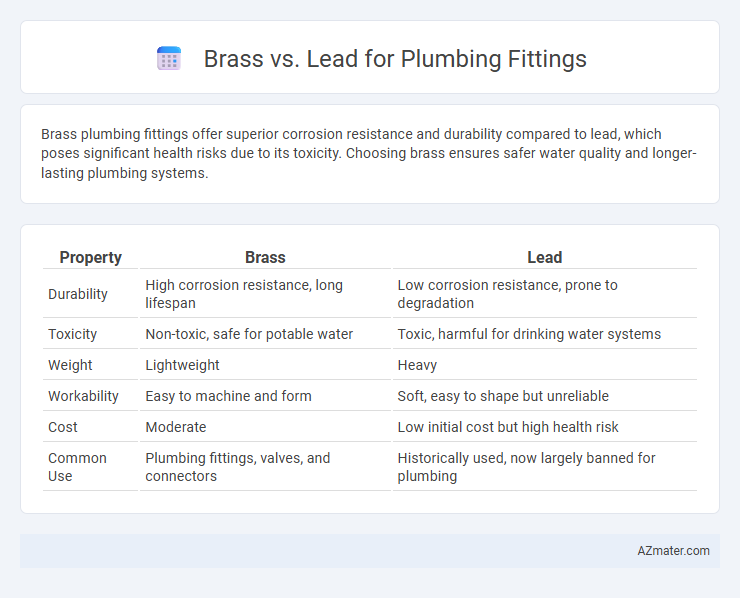Brass plumbing fittings offer superior corrosion resistance and durability compared to lead, which poses significant health risks due to its toxicity. Choosing brass ensures safer water quality and longer-lasting plumbing systems.
Table of Comparison
| Property | Brass | Lead |
|---|---|---|
| Durability | High corrosion resistance, long lifespan | Low corrosion resistance, prone to degradation |
| Toxicity | Non-toxic, safe for potable water | Toxic, harmful for drinking water systems |
| Weight | Lightweight | Heavy |
| Workability | Easy to machine and form | Soft, easy to shape but unreliable |
| Cost | Moderate | Low initial cost but high health risk |
| Common Use | Plumbing fittings, valves, and connectors | Historically used, now largely banned for plumbing |
Understanding Brass and Lead Plumbing Fittings
Brass plumbing fittings, composed primarily of copper and zinc, offer excellent corrosion resistance, durability, and are safe for potable water systems, making them a preferred choice in modern plumbing. Lead fittings, once common, have been largely phased out due to lead's toxicity and potential health risks, particularly its ability to leach into drinking water and cause serious contamination. Understanding the material properties and safety implications ensures the selection of brass over lead, promoting long-term plumbing reliability and health safety.
Historical Use of Brass and Lead in Plumbing
Brass, an alloy of copper and zinc, has been widely used in plumbing fittings since the 19th century due to its durability, corrosion resistance, and malleability. Lead, historically favored for its ease of casting and flexibility, was extensively used in plumbing systems in ancient civilizations, including Roman aqueducts, but its use declined sharply after the discovery of its toxicity. The transition from lead to brass fittings in plumbing reflects advancements in health standards and materials science aimed at preventing lead poisoning and ensuring safer water supply systems.
Chemical Composition Comparison
Brass plumbing fittings primarily consist of copper and zinc, offering corrosion resistance and durability due to copper's antimicrobial properties and zinc's strength-enhancing effects. Lead, a toxic metal once common in plumbing, has a simpler composition that poses significant health risks due to leaching into potable water. Modern regulations favor brass over lead because brass's chemical composition ensures safer water quality and longer-lasting plumbing systems.
Durability and Longevity
Brass plumbing fittings offer superior durability and corrosion resistance compared to lead, making them ideal for long-term use in water systems. Lead fittings pose significant health risks due to potential leaching and tend to degrade faster under pressure and temperature variations. The longevity of brass fittings ensures reduced maintenance costs and safer water quality over time.
Health and Safety Concerns
Brass plumbing fittings are favored over lead due to their significantly lower toxicity and reduced risk of lead poisoning, making them safer for potable water systems. Lead fittings, now largely banned in many countries, pose severe health risks including neurological damage, particularly in children, when they leach into drinking water. Using brass fittings helps comply with modern health regulations and ensures safer water quality in residential and commercial plumbing installations.
Environmental Impact
Brass plumbing fittings, composed primarily of copper and zinc, offer improved environmental benefits due to their recyclability and lower toxicity compared to lead, which poses significant health risks through contamination of water supplies. Lead fittings can leach harmful metals, contributing to soil and water pollution, whereas brass's durability reduces the need for frequent replacements, minimizing material waste. Choosing brass over lead supports safer water quality and aligns with sustainability goals by limiting hazardous waste and promoting recyclable materials in plumbing systems.
Installation and Maintenance Differences
Brass plumbing fittings offer superior corrosion resistance and ease of installation due to their malleability, resulting in fewer leaks and longer-lasting connections compared to lead fittings. Lead fittings require careful handling and specialized tools during installation to prevent contamination and ensure safety, making maintenance more challenging. Regular inspections of brass fittings are simpler and less frequent, whereas lead fittings demand ongoing monitoring for potential toxic leaching and deterioration.
Cost Analysis: Brass vs Lead
Brass plumbing fittings typically cost more upfront than lead fittings due to higher material and manufacturing expenses but offer superior durability and corrosion resistance, reducing long-term maintenance costs. Lead fittings are cheaper initially but pose significant health risks and regulatory restrictions, leading to potential replacement expenses and liability concerns. Evaluating total cost of ownership, brass is more cost-effective over time despite higher initial investment.
Regulatory Standards and Compliance
Brass plumbing fittings frequently meet stringent regulatory standards such as NSF/ANSI 61 and NSF/ANSI 372, ensuring low lead content and safe potable water use. In contrast, lead-based fittings are largely banned or restricted under laws like the Safe Drinking Water Act (SDWA) due to health risks from lead exposure. Compliance with these regulations makes brass the preferred choice for modern plumbing systems prioritizing safety and legal adherence.
Choosing the Right Material for Your Plumbing System
Brass plumbing fittings offer excellent corrosion resistance, durability, and compatibility with both hot and cold water systems, making them a reliable choice for long-term plumbing installations. Lead fittings, once common, have been largely phased out due to toxicity concerns and their negative health impact, especially in drinking water systems. Selecting brass over lead ensures compliance with modern safety standards while providing optimal performance and longevity for your plumbing system.

Infographic: Brass vs Lead for Plumbing Fitting
 azmater.com
azmater.com